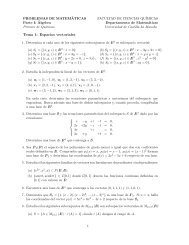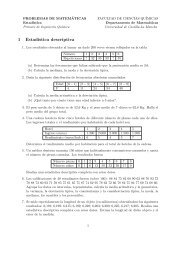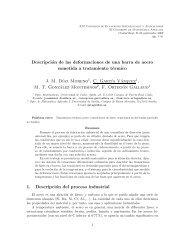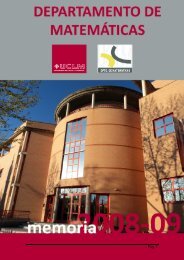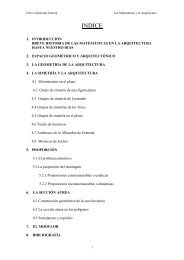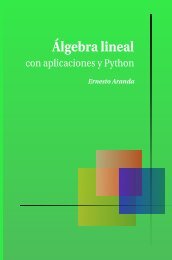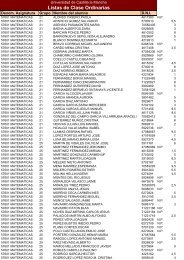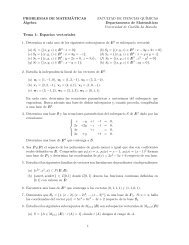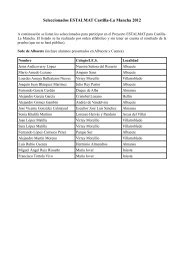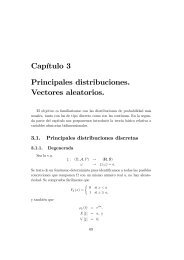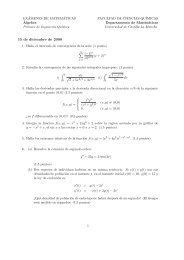Tema 1: Ecuaciones diferenciales ordinarias de primer orden
Tema 1: Ecuaciones diferenciales ordinarias de primer orden
Tema 1: Ecuaciones diferenciales ordinarias de primer orden
You also want an ePaper? Increase the reach of your titles
YUMPU automatically turns print PDFs into web optimized ePapers that Google loves.
PROBLEMAS DE MATEMÁTICAS<br />
Parte III: <strong>Ecuaciones</strong> <strong>diferenciales</strong><br />
Primero <strong>de</strong> Ingeniería Química<br />
FACULTAD DE CIENCIAS QUÍMICAS<br />
Departamento <strong>de</strong> Matemáticas<br />
Universidad <strong>de</strong> Castilla-La Mancha<br />
<strong>Tema</strong> 1: <strong>Ecuaciones</strong> <strong>diferenciales</strong> <strong>ordinarias</strong> <strong>de</strong> <strong>primer</strong> or<strong>de</strong>n<br />
1. Resuelve las siguientes ecuaciones:<br />
a) y ′ = y2 + y<br />
t 2 b) ty ′ + (2t 2 − 1)coty = 0<br />
− t<br />
c) (t 2 + 1)dy = (y + 1)(t + √ t 2 + 1)dt d) t 2 (y + 1) 2 (y ′ − 1) = y 2 − 2t 2 y + 1<br />
2. Resuelve las siguientes ecuaciones:<br />
(a) y ′ = −2tylog|y|<br />
t 2 .<br />
(b) y ′ seny + ysent<br />
=<br />
cos t − t cos y .<br />
(c) y ′ = −3t2 − 2ysen2t<br />
2sen 2 t + 3y 2 .<br />
3. Encuentra el valor <strong>de</strong> b para que las siguientes ecuaciones sean exactas y con este valor<br />
resuélvelas:<br />
(a) (ty 2 + bt 2 y)dt + (t + y)t 2 dy = 0, y(1) = −1.<br />
(b) (ye 2ty + t)dt + (tbe 2ty )dy = 0, y(−1) = 0.<br />
4. Resuelve las siguientes ecuaciones con valor inicial:<br />
(a) tdt + ye −t dy = 0, y(0) = √ 2.<br />
(b) y ′ =<br />
2t , y(0) = −2.<br />
y+t 2 y<br />
( ) π<br />
(c) sen2tdt + cos 3ydy = 0, y = π 2 3 .<br />
5. Comprueba que las siguientes ecuaciones no son exactas, pero se pue<strong>de</strong>n transformar en<br />
exactas multiplicándolas por el factor integrante dado.<br />
(a) t 2 y 3 dt + t(1 + y 2 )dy = 0, µ(t, y) = 1<br />
ty 3 .<br />
(b) (1 − ty)dt + (1 − t 2 )dy = 0, µ(t, y) =<br />
1<br />
√<br />
1 − t 2 .<br />
(c) (3ty + y 2 )dt + (t 2 + ty)dy = 0, µ(t, y) = (ty(2t + y)) −1 .<br />
6. Resuelve las siguientes ecuaciones buscando un factor integrante a<strong>de</strong>cuado:<br />
(a) (t 3 + y 4 )dt + 8ty 3 dy = 0.<br />
(b) ty 3 dt + (t 2 y 2 − 1)dy = 0.<br />
1
7. Resuelve la siguiente ecuación buscando un factor integrante que <strong>de</strong>penda únicamente <strong>de</strong><br />
t + y:<br />
(7t 3 + 3t 2 y + 4y)dt + (4t 3 + t + 5y)dy = 0<br />
8. Dada la ecuación diferencial:<br />
yf(xy)dx + xg(xy)dy = 0<br />
<strong>de</strong>termina un factor integrante para esta ecuación y aplicarlo para integrar la ecuación:<br />
y(x 2 y 2 − 1)dx + x(x 2 y 2 + 1)dy = 0<br />
9. Dada la ecuación:<br />
( ) ( )<br />
y y<br />
t cos y ′ = y cos − t<br />
t t<br />
(a) Encuentra el factor integrante más simple.<br />
(b) Halla otro factor integrante que sea función <strong>de</strong> y/t.<br />
(c) Obtén la solución <strong>de</strong> la ecuación diferencial.<br />
10. Dada una ecuación diferencial <strong>de</strong> la forma: P (t, y)dt + Q(t, y)dy = 0, se pi<strong>de</strong>:<br />
(a) Halla la condición que tienen que cumplir P y Q para que la ecuación admita un<br />
factor integrante función <strong>de</strong> t + y.<br />
(b) Aplica lo anterior para hallar el factor integrante <strong>de</strong> la ecuación:<br />
11. Dada la ecuación:<br />
(2ty − y 2 − y)dt + (2ty − t 2 − t)dy = 0<br />
(t 2 y + y 3 − ty)dt + t 2 dy = 0<br />
Halla un factor integrante <strong>de</strong> la forma t −3 f(y/t) y resuélvela.<br />
12. Resuelve las siguientes ecuaciones <strong>diferenciales</strong>:<br />
a) (t 2 + y 2 )dt = 2tydy b) ydt + (y − t)dy = 0<br />
c) (t + 4y)dt = 3tdy d) ydt + ( √ t 2 + y 2 − t)dy = 0<br />
e) tdy − ydt = √ t 2 + y 2 dy f) (2t + 3y)dt + (y + 2)dy = 0<br />
g) y ′ = t − 5y + 5<br />
y − 5t − 1<br />
i) y ′ = y + 2t − 1<br />
h) y ′ =<br />
(2t + 6y − 18)2<br />
(9t + 2y + 19) 2<br />
j) y ′ = ( t − y − 1<br />
4t + 2y + 1<br />
2t − 2y + 1 )2<br />
k) (t + y)y ′ = 2y − 1 l) (3t + 4y + 1)dy + (2t + 3y + 1)dt = 0<br />
13. Resuelve las siguientes ecuaciones <strong>de</strong> <strong>primer</strong> or<strong>de</strong>n:<br />
a) (y + 1)dx + (xy + y 2 + y + 1)dy = 0 b) 2 x + 1 (x + 1)2<br />
dx −<br />
y + 1 (y + 1) 2 dy = 0<br />
c) x(x + y)dy = (x 2 + y 2 )dx d) y ′ = (1 − y 2 )tanx<br />
e) (9x + 21y + 3)dy = (7x − 5y + 45)dx f) (x − y) 2 dy = (x − y + 1) 2 dx<br />
g) y 2 dx + (xy + 1)dy = 0 h) (2x 2 + xy + 1)ydx + (x + 2y)(x 2 + 1)dy = 0<br />
i) xsen y (<br />
x dy = ysen y )<br />
x + x dx<br />
2
14. Calcula las trayectorias ortogonales <strong>de</strong> la familia <strong>de</strong> curvas dada:<br />
a) 3x + 4y = c 1 ; b) y =<br />
x<br />
1 + c 1 x ; c) 4y + x2 + 1 + c 1 e 2y = 0<br />
15. Encuentra el miembro <strong>de</strong> la familia <strong>de</strong> trayectorias ortogonales <strong>de</strong> x + y = c 1 e y que<br />
pasa por (0, 5).<br />
15. Calcula las isoclinas (curvas <strong>de</strong> igual pendiente) <strong>de</strong> las siguientes ecuaciones y esbozar las<br />
gráficas <strong>de</strong> las soluciones<br />
a) y ′ = x y ; b) y′ = −y<br />
x ; c) y′ = 2y − 1; d) y ′ = y 2 − 3y + 2<br />
16. La <strong>de</strong>scomposición <strong>de</strong> N 2 O bajo la influencia <strong>de</strong> un catalizador <strong>de</strong> platino viene dada por<br />
la ecuación diferencial:<br />
dx<br />
dt = k a − x<br />
1 + bx<br />
don<strong>de</strong> a es la concentración <strong>de</strong> N 2 O en el instante inicial t = 0, b es una constante y x(t)<br />
es la concentración <strong>de</strong> producto en el instante t. Si para t = 0 es x(0) = 0, resolver la<br />
ecuación diferencial y <strong>de</strong>terminar la expresión <strong>de</strong> la vida media <strong>de</strong> la sustancia (vida media<br />
<strong>de</strong> una sustancia es el tiempo T que tarda en reducirse a la mitad).<br />
17. a) Integra la siguiente ecuación correspondiente a la velocidad <strong>de</strong> una reacción <strong>de</strong> tercer<br />
or<strong>de</strong>n completa:<br />
dx<br />
dt<br />
= k(a − x)(b − x)(c − x)<br />
con condición inicial x(0) = 0, supuesto que a > b > c > 0. Calcular la vida media T <strong>de</strong><br />
esa reacción. ¿Qué ocurre con la solución si a = b o b = c? ¿Y si a=b=c?<br />
b) Integra la ecuación diferencial <strong>de</strong> la velocidad <strong>de</strong> reacción <strong>de</strong> la siguiente reacción<br />
incompleta:<br />
dx<br />
dt<br />
= 3(2 − x)(1 − x) − (1 + x)(2 + x)<br />
con dato inicial x(0) = 0. ¿Para qué valor <strong>de</strong> la variable x cesa ésta su variación?<br />
c) Resuelve la ecuación <strong>de</strong> la velocidad <strong>de</strong> reacción <strong>de</strong> una reacción <strong>de</strong> <strong>primer</strong> or<strong>de</strong>n autocatalítica:<br />
con dato inicial x(0) = 0.<br />
dx<br />
dt<br />
= k(a − x)(b + x)<br />
d) La velocidad <strong>de</strong> reacción <strong>de</strong> una reacción <strong>de</strong> <strong>primer</strong> or<strong>de</strong>n con reacción inversa viene<br />
dada por:<br />
dx<br />
dt = k 1(a − x) − k 2 x<br />
Resuélvela si el dato inicial es x(0) = x 0 . Particulariza para el caso en que k 1 = k 2 =<br />
100s −1 , a = 1mol/l y x 0 = 0. ¿Cuánto vale la solución cuando t = 0.0005s, 0.01s y 1s?<br />
3
18. Calcula la concentración en función <strong>de</strong>l tiempo <strong>de</strong> una sustancia B que se forma a partir<br />
<strong>de</strong> una sustancia A con constante <strong>de</strong> velocidad k 1 y que se transforma en la sustancia C<br />
con constante <strong>de</strong> velocidad k 2 :<br />
A k 1<br />
→ B k 2<br />
→ C<br />
con condiciones iniciales C A (0) = 5 y C B (0) = 0. Plantear la ecuación diferencial que da<br />
la variación <strong>de</strong> la concentración <strong>de</strong> A con el tiempo y utilizar la solución para plantear la<br />
ecuación diferencial que da la variación <strong>de</strong> B con el tiempo. Discutir el comportamiento<br />
<strong>de</strong>l sistema en función <strong>de</strong> las constantes <strong>de</strong> velocidad.<br />
19. Un cohete con masa inicial M 0 <strong>de</strong>spega en el instante t = 0. La masa <strong>de</strong>crece con el tiempo<br />
porque el combustible se gasta a una velocidad <strong>de</strong> combustión constante r; así la masa en<br />
el instante t es M(t) = M 0 − rt. Si el empuje proporcionado por los motores es una fuerza<br />
constante F y el movimiento es vertical con velocidad v, la segunda ley <strong>de</strong> Newton implica<br />
que:<br />
F = M(t)g + d dt (M(t)v(t))<br />
don<strong>de</strong> se ha <strong>de</strong>spreciado la fuerza <strong>de</strong> resistencia <strong>de</strong>l aire.<br />
a) Resuelve la ecuación diferencial anterior. Si la masa <strong>de</strong>l cohete en el instante en que se<br />
agota el combustible es M 1 , calcula la velocidad en ese instante.<br />
b) Resuelve la ecuación anterior suponiendo a<strong>de</strong>más que la fuerza <strong>de</strong> resistencia <strong>de</strong>l aire<br />
es proporcional a la velocidad <strong>de</strong>l cohete, con una constante <strong>de</strong> proporcionalidad λ.<br />
c) Si el cohete alcanzara una altura suficientemente gran<strong>de</strong> no se pue<strong>de</strong> suponer que g es<br />
constante, en cuyo caso <strong>de</strong>bemos utilizar la correción g = g 0 R 2 T /z2 , siendo R T el radio <strong>de</strong><br />
la tierra, z la distancia <strong>de</strong>l cohete al centro <strong>de</strong> la tierra y g 0 = 9.8m/s 2 . ¿De qué tipo es<br />
la ecuación diferencial que <strong>de</strong>scribe este problema?<br />
20. Dado un circuito eléctrico simple, la ecuación que lo gobierna es:<br />
L dI<br />
dt + RI = E<br />
don<strong>de</strong> en este caso E = voltaje = constante; R = resistencia = constante > 0; L =<br />
inductancia = constante > 0; I = intensidad <strong>de</strong> corriente = I(t); t = tiempo.<br />
Resuelve la ecuación en I con un valor dado I 0 para t = 0. Dibuja la gráfica <strong>de</strong> la solución<br />
I(t). ¿Qué suce<strong>de</strong> cuando t → ∞?<br />
21. Si la población <strong>de</strong> un país se duplica en 50 años, ¿en cuántos años será el triple suponiendo<br />
que la velocidad <strong>de</strong> aumento es proporcional al número <strong>de</strong> habitantes?<br />
22. En cierto cultivo <strong>de</strong> bacterias la velocidad <strong>de</strong> aumento es proporcional al número presente.<br />
a) Si se ha hallado que el número se duplica en 4 horas, ¿qué número cabe esperar al cabo<br />
<strong>de</strong> 12 horas? b) Si hay 10 4 al cabo <strong>de</strong> una hora y 2 · 10 4 al cabo <strong>de</strong> 5 horas, ¿cuántos había<br />
al principio?<br />
4
1 <strong>Tema</strong> 2: <strong>Ecuaciones</strong> <strong>diferenciales</strong> <strong>ordinarias</strong> <strong>de</strong> or<strong>de</strong>n superior<br />
1. Integra las siguientes ecuaciones <strong>diferenciales</strong>:<br />
a) y ′′ + y ′ − 2y = t + 2te t b) y ′′ + 3y ′ + 2y = 0, y(0) = 1, y ′ (0) = −1<br />
c) y ′′ − 2y ′ + 5y = e t cos(2t) d) y ′′ − 2y ′ + 10y = sen(3t) + e t<br />
e) y ′′′ + y ′′ − 2y ′ = −e 3t f) y ′′′ + y ′′ + y ′ + y = cos t + 2sen(3t)<br />
g) y ′′ + y = tgt h) y ′′ + y = e 2t cos(3t)<br />
i) y ′′ − ky = 0 j) y ′′ + y = ctgt<br />
k) y ′′ − 2y ′ + y = e t sent + e 2t cos t l) y ′′ + y = te t + 2sent<br />
ll) t 2 y ′′ − ty ′ + y = 2t m) (t + 1) 2 y ′′ − 3(t + 1)y ′ + 4y = (1 + t) 3<br />
n) y ′′ + ty ′ + y = 0 o) y ′′ = ty<br />
2. Integra la ecuación diferencial:<br />
y ′′ + 2y ′ − 8y = e 2x ( 6<br />
x − 1 x 2 )<br />
3. Halla la transformada inversa <strong>de</strong> Laplace <strong>de</strong> las siguientes funciones:<br />
a) 1 s 5 b) 3s + 5<br />
s 2 + 7<br />
3s − 2<br />
2s + 4<br />
e)<br />
s 3 (s 2 f)<br />
+ 4) s 3 + 2s 2 − 5s − 6<br />
e −s<br />
i)<br />
j) e−2s<br />
s(s + 1) s 3<br />
1<br />
c)<br />
s 3 + 5s 2 + 2s − 8<br />
s<br />
g)<br />
s 3 + 2s 2 − 4s − 8<br />
s + 1<br />
d)<br />
s 5 + 6s 4 + 12s 3 + 8s 2<br />
h) e−πs/2<br />
s 2 + 9<br />
4. Encuentra la solución general <strong>de</strong> las siguientes ecuaciones:<br />
a) y ′′ (t) − 4y ′ (t) + 4y(t) = e 2t t 3 b) y ′′ (t) − y ′ (t) = e t cos t<br />
c) y ′′ (t) + 4y ′ (t) = sentH 2π (t)<br />
5. Resuelve los siguientes problemas <strong>de</strong> valor inicial:<br />
⎧<br />
{<br />
y<br />
a)<br />
′ (t) + 4y(t) = e −4t ,<br />
⎪⎨<br />
b)<br />
y(0) = 2.<br />
⎪⎩<br />
⎧<br />
⎪⎨<br />
c)<br />
⎪⎩<br />
y ′′ (t) + y(t) = senh(t),<br />
y(0) = 0,<br />
y ′ (0) = 0.<br />
don<strong>de</strong> f(t) =<br />
{<br />
t, si 0 ≤ t < 1<br />
0, si t ≥ 1<br />
d)<br />
y ′′ (t) + 5y ′ (t) + 4y(t) = 0,<br />
y(0) = 0,<br />
y ′ (0) = 1.<br />
{<br />
y ′ (t) + 2y(t) = f(t),<br />
y(0) = 0.<br />
6. Un cuerpo que pesa 0.1kg. estira un resorte <strong>de</strong> 6cm. Dicho cuerpo se suelta en t = 0 <strong>de</strong>s<strong>de</strong><br />
un punto que está a 8cm bajo la posición <strong>de</strong> equilibrio, con una velocidad dirigida hacia<br />
arriba <strong>de</strong> 0.1m/s. Determina la función x(t) que <strong>de</strong>scribe el movimiento libre resultante.<br />
7. En el problema anterior, ¿cuál sería el movimiento resultante si se sabe que el medio ofrece<br />
una resistencia igual a la velocidad instantánea <strong>de</strong> la pesa?.<br />
5
<strong>Tema</strong> 3: Sistemas <strong>de</strong> ecuaciones <strong>diferenciales</strong> <strong>ordinarias</strong><br />
1. Calcula la solución general <strong>de</strong> los siguientes sistemas:<br />
a)<br />
{<br />
x ′ = x + 3y,<br />
y ′ = 5x + 3y,<br />
b)<br />
{<br />
x ′ = 4x + y,<br />
y ′ = −9x − 2y,<br />
c)<br />
{<br />
x ′ = 2x + 3y,<br />
y ′ = 3x + 2y,<br />
d)<br />
{<br />
x ′ = 4x + y,<br />
y ′ = 6x + 5y,<br />
2. Resuelve los siguientes problemas <strong>de</strong> valor inicial:<br />
⎧<br />
x ⎪⎨<br />
′ = x 2 ,<br />
a) y ′ = x − y ⎪⎩ 2 ,<br />
⎧ x(0) = 3, y(0) = 5.<br />
x<br />
⎪⎨<br />
′ = y + z,<br />
y<br />
c)<br />
′ = x + y + 2z,<br />
z<br />
⎪⎩<br />
′ = x + z,<br />
x(0) = 1, y(0) = 1, z(0) = 0.<br />
⎧<br />
⎪⎨ x ′ = 2x + 4y,<br />
b) y ′ = −x + 6y,<br />
⎪⎩ x(0) = −1, y(0) = 6.<br />
⎧<br />
⎪⎨<br />
d)<br />
⎪⎩<br />
x ′ = x − 12y − 14z,<br />
y ′ = x + 2y − 3z,<br />
z ′ = x + y − 2z,<br />
x(0) = 4, y(0) = 6, z(0) = 7.<br />
3. Aplica la transformada <strong>de</strong> Laplace para <strong>de</strong>terminar la solución <strong>de</strong> los sistemas siguientes:<br />
⎧<br />
⎪⎨ x ′ 1 (t) = x ⎧<br />
1(t) + x 2 (t), t > 0, ⎪⎨ x ′ (t) = 3x(t) + y(t) + e 2t , t > 0,<br />
a) x ′ 2 ⎪⎩<br />
(t) = 6x 1(t) + 2x 2 (t) + t, t > 0, b) y ′ (t) = −x(t) + y(t) + e 2t , t > 0,<br />
x 1 (0) = x 2 (0) = 0.<br />
⎪⎩ x(0) = y(0) = 1.<br />
⎧<br />
⎪⎨<br />
c)<br />
⎪⎩<br />
2x ′ + y ′ − y = t,<br />
x ′ + y ′ = t 2 ,<br />
x(0) = 1, y(0) = 0.<br />
4. Aplica el método <strong>de</strong> la transformada <strong>de</strong> Laplace para resolver el siguiente sistema que<br />
<strong>de</strong>scribe el comportamiento <strong>de</strong> la corriente <strong>de</strong> un circuito eléctrico:<br />
⎧<br />
⎪⎨<br />
⎪⎩<br />
L 1 I ′ 2 (t) + (R 1 + R 2 )I 2 (t) + R 1 I 3 (t) = E(t),<br />
L 2 I ′ 3 (t) + R 1I 2 (t) + R 1 I 3 (t) = E(t),<br />
I 1 (t) − I 2 (t) − I 3 (t) = 0,<br />
I 1 (0) = I 2 (0) = I 3 (0) = 0,<br />
siendo R 1 = 6 ohmios, R 2 = 5 ohmios, L 1 = L 2 = 1 henrio y E(t) = 50sent voltios.<br />
5. En un circuito L-R-C se suministra una diferencia <strong>de</strong> potencial constante E(t) ≡ E 0<br />
durante un intervalo <strong>de</strong> tiempo (0, T ) <strong>de</strong>spués <strong>de</strong>l cual la pila se <strong>de</strong>scarga y E(t) = 0 para<br />
t > T .<br />
(a) Determina la carga y la intensidad en el circuito en cada instante <strong>de</strong> tiempo bajo el<br />
supuesto Q(0) = I(0) = 0.<br />
(b) ¿Cuáles son los valores <strong>de</strong> la carga y la intensidad en el instante en que se agota la<br />
pila?.<br />
(c) ¿Cuál es la carga <strong>de</strong> la pila para tiempos gran<strong>de</strong>s?.<br />
(d) ¿Qué ocurre para otros valores iniciales <strong>de</strong> Q e I?.<br />
6
6. Consi<strong>de</strong>remos dos masas m 1 y m 2 sujetas a dos resortes acoplados (es <strong>de</strong>cir, conectados<br />
entre sí) A y B <strong>de</strong> masas insignificantes y constantes k 1 y k 2 respectivamente. Denotemos<br />
por x 1 (t) y x 2 (t) los <strong>de</strong>splazamientos verticales <strong>de</strong> las masas con respecto a sus posiciones <strong>de</strong><br />
equilibrio. Si no se aplican fuerzas externas al sistema y no hay fuerzas <strong>de</strong> amortiguación,<br />
la segunda Ley <strong>de</strong> Newton permite <strong>de</strong>ducir que el movimiento <strong>de</strong>l sistema acoplado viene<br />
<strong>de</strong>scrito por el siguiente sistema <strong>de</strong> ecuaciones lineales <strong>de</strong> segundo or<strong>de</strong>n<br />
{<br />
m1 x ′′<br />
1 = −k 1x 1 + k 2 (x 2 − x 1 ),<br />
m 2 x ′′<br />
2 = −k 2(x 2 − x 1 ),<br />
Resolver el sistema anterior cuando k 1 = 6, k 2 = 4 y m 1 = m 2 = 1 sabiendo que las masas<br />
parten <strong>de</strong> sus posiciones <strong>de</strong> equilibrio con velocida<strong>de</strong>s unitarias, pero en sentidos opuestos.<br />
7. El sistema: {<br />
C<br />
′<br />
A (t) = −k 11 C A (t) + k 12 C B (t),<br />
C ′ B (t) = −(k 12 + k 21 )C B (t) + k 11 C A (t) + k 22 C C (t),<br />
expresa la evolución, a partir <strong>de</strong> un instante inicial, <strong>de</strong> las concentraciones <strong>de</strong> tres reactivos<br />
A, B y C en un proceso químico gobernado por una pareja <strong>de</strong> reacciones reversibles<br />
A ⇀↽ B ⇀↽ C siendo k 11 y k 12 las velocida<strong>de</strong>s <strong>de</strong> las reacciones directas e inversas <strong>de</strong> la<br />
<strong>primer</strong>a y k 21 y k 22 las correspondientes <strong>de</strong> la segunda. Sabiendo que en cualquier instante<br />
se verifica que C A (t) + C B (t) + C C (t) = 1, calcular las concentraciones C A (t) y C B (t) en<br />
el caso en que k 11 = k 12 = k 21 = k 22 = 1, C A (0) = 1/4 y C B (0) = 3/10.<br />
8. Reduce las siguientes ecuaciones y sistemas <strong>de</strong> ecuaciones <strong>de</strong> or<strong>de</strong>n superior a sistemas <strong>de</strong><br />
ecuaciones <strong>de</strong> <strong>primer</strong> or<strong>de</strong>n y resuelve los sistemas planteados:<br />
a) 2y ′′′ − 6y ′′ + 4y ′ + y = sent. b) 4y ′′′ + y = e t .<br />
{ {<br />
x<br />
c)<br />
′′ − x ′ + 5x + 2y ′′ = e t<br />
x<br />
−2x + y ′′ + 2y = 3t 2 . d)<br />
′′ − 2y ′′ = sent<br />
x ′′ + y ′′ = cos t<br />
.<br />
7




